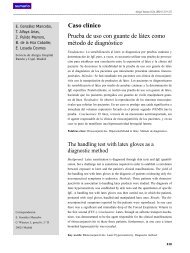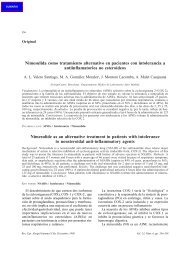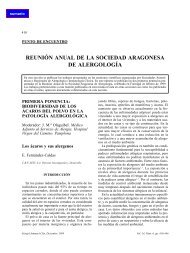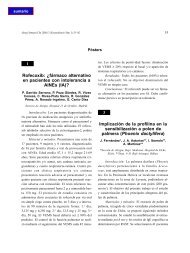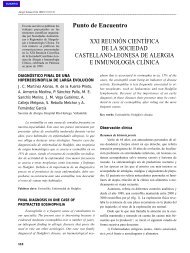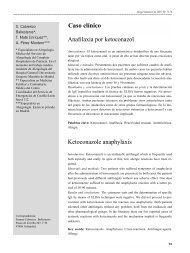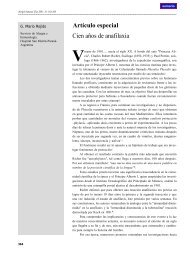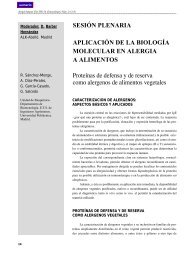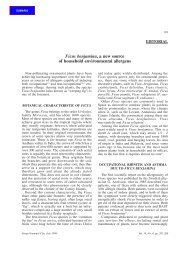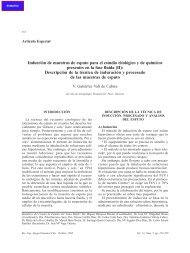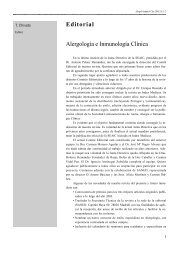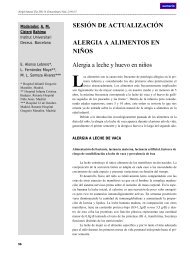Antihistamines: a review
Antihistamines: a review
Antihistamines: a review
Create successful ePaper yourself
Turn your PDF publications into a flip-book with our unique Google optimized e-Paper software.
No. 5 H1 <strong>Antihistamines</strong>: a <strong>review</strong> 305<br />
Table III. Inhibitors of the 3A4 family of cytochrome P-450<br />
(CYP3A4)<br />
Enzymatic inhibitors<br />
Cimetidine, Ranitidine<br />
Clarythromycine, Erythromycine, Troleandomycine (TAO)<br />
Ketoconazole, Itraconazole<br />
Fluvoxamine, Norfluoxetine (a metabolite of fluoxetine)<br />
Natural flavonoids in grape juice<br />
Enzymatic substrates<br />
Astemizole, Terfenadine, Ebastine, Loratadine, Mizolastine<br />
Cisapride<br />
Erythromycin<br />
A number of added risk factors for the development<br />
of torsades de pointes in patients under treatment<br />
with antihistamines have been considered,<br />
such as previous hepatic dysfunction, hypokaliaemia,<br />
hypomagnesaemia, bradycardia situations and<br />
the congenital long QT syndrome (Table IV) 33,40 .<br />
Even though these side effects have not been as<br />
intensively investigated for other H1 antagonists, a<br />
quinidine-like effect on myocardial conduction has<br />
been described for antihistamines as a group 9. A<br />
cohort study actually demonstrated a greater incidence<br />
of ventricular arrhythmias and cardiac arrest<br />
in the group of patients receiving O.T.C. antihistamines<br />
as compared to the groups receiving terfenadine<br />
or clemastine 53 . However, other studies have<br />
not evidenced actions on cardiac electrophysiology<br />
for chlorphenyramine or pirylamine, suggesting<br />
that this may be a piperidine effect or a specific one<br />
of astemizole, terfenadine and ebastine 54 .<br />
The initial worry that cardiotoxicity might<br />
represent a class effect of the antihistamines,<br />
however, appears to be unfounded 38 considering<br />
that fexofenadine (with negligible hepatic metabolism<br />
24 ) and probably further active metabolites<br />
with potent H 1-antagonist action 45 are devoid of<br />
this adverse effect. Whatever the case may be, it<br />
appears to be important to keep in mind all the<br />
factors already pointed out (Table IV) when prescribing<br />
antihistamines in clinical practise.<br />
ANTIHISTAMINES IN BRONCHIAL ASTHMA<br />
There is a long-standing belief that antihistamines<br />
may be harmful in asthmatic patients because<br />
Table IV. Risk factors for ventricular arrhythmias in patients<br />
receiving antihistamines 33,40<br />
1. Coadministration of other drugs<br />
a. Agents which prolong the QT interval, such as quinidine<br />
or erythromycin<br />
b. Enzymatic substrates/inhibitors of CYP3A4 (Table III)<br />
2. Preexistent liver disease<br />
3. Electrolyte balance derangements<br />
a. Hypokaliemia<br />
b. Hypomagnesemia<br />
4. Congenital long QT syndrome<br />
5. Bradycardia situations<br />
of the mucosal dryness effect of the anticholinergic<br />
action of the initial preparations to which the<br />
induction of bronchial asthma in children was<br />
ascribed 55 . However, and considering that histamine<br />
causes bronchial constriction and oedema, it<br />
appears to be logical to think that antihistamines<br />
might revert some of its effects on the bronchial<br />
tree, and that they are not contraindicated in asthmatic<br />
patients 56 . In this context, there is ample<br />
experience in Spain with ketotifen, and a number<br />
of studies suggest that azelastine, cetirizine, loratadine,<br />
terfenadine and astemizole might at least<br />
block the bronchospasm induced by histamine 57 .<br />
In any case, the effects of histamine in the latephase<br />
reaction have not been fully clarified and<br />
further studies are warranted for defining the<br />
effects of H1 antagonism in this late phase, particularly<br />
in the case of the antihistamines with additional<br />
antiinflammatory properties 15 .<br />
As the aim of the present <strong>review</strong> is to try to<br />
define the place of the principal antihistamines in<br />
the therapeutic armamentarium, a brief chemical<br />
and therapeutic discussion of the main H1 antihistamines<br />
currently used in Spain follows as a conclusion.<br />
"CLASSICAL" H1 ANTIHISTAMINES<br />
Chlorphenyramine and dextrochlorphenyramine.<br />
The prototypes of the alkylamines (propylamines),<br />
chlorphenyramine and its isomer dextrochlorphenyramine<br />
are used in a host of O.T.C.<br />
"anticatarrhal" preparations, usually in associations<br />
with vasoconstrictors, expectorants and analgesics.<br />
Dexchlorphenyramine is furthermore the<br />
only antihistamine available for parenteral use in




